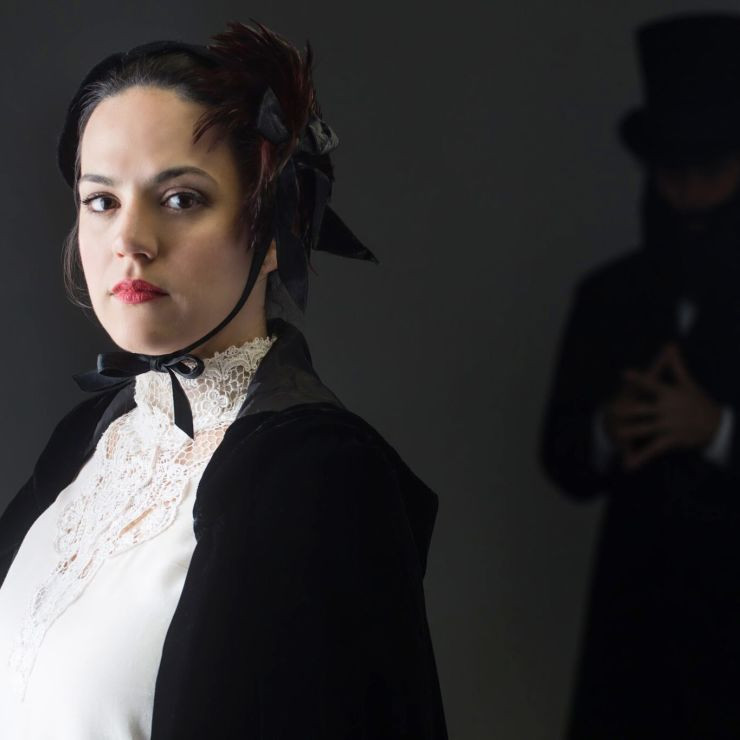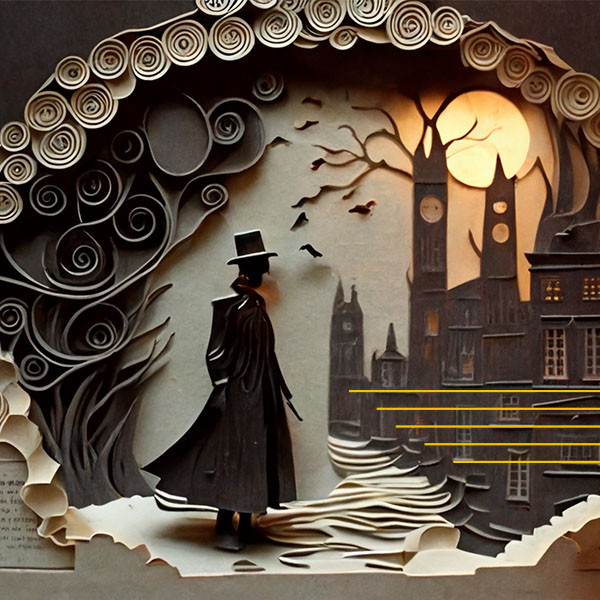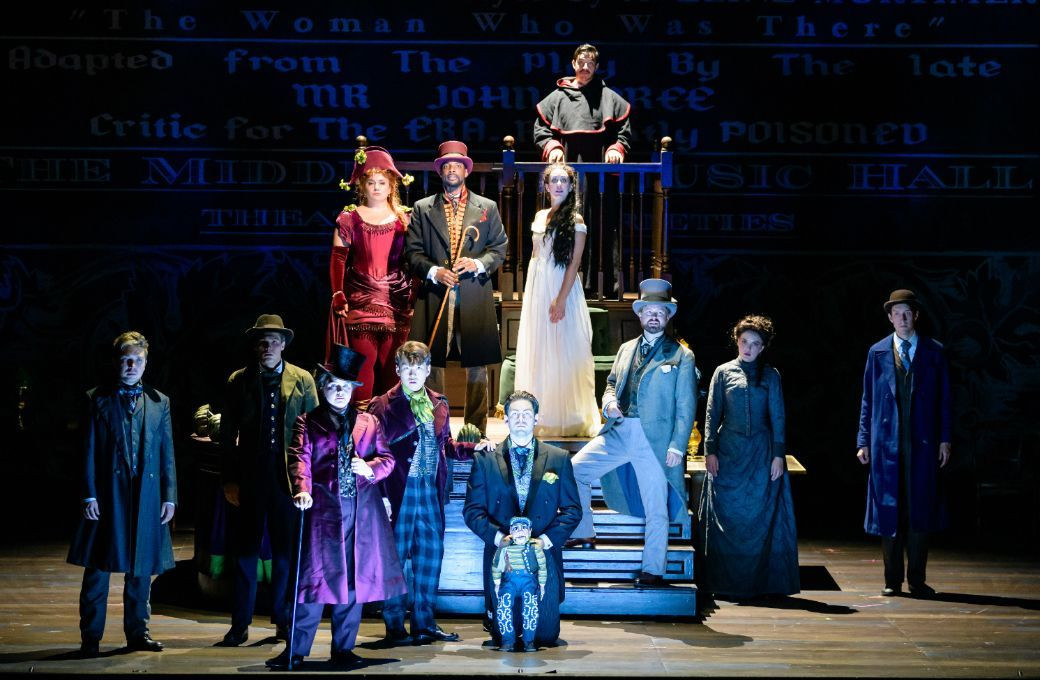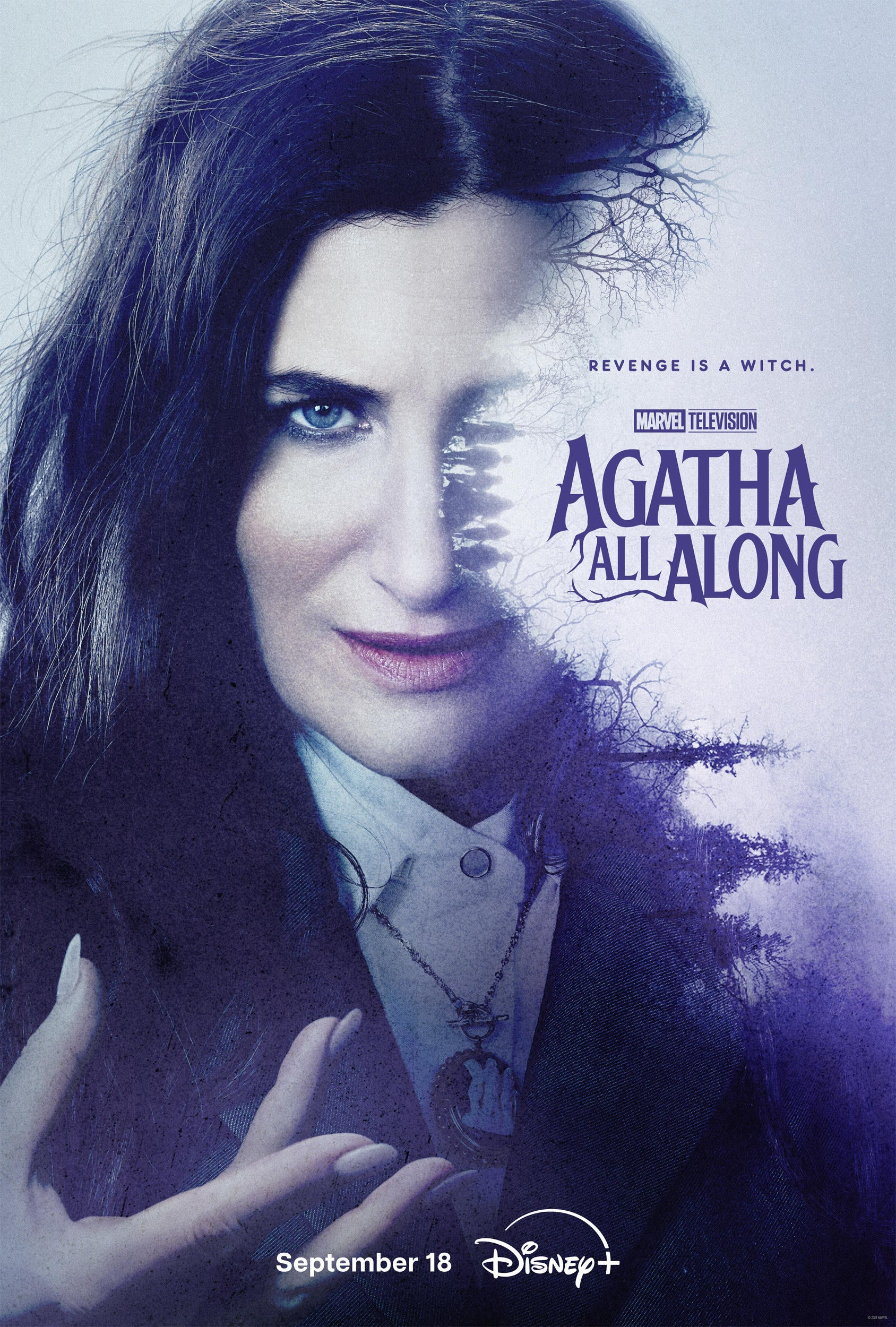How do these two operas speak to each other, though separated by more than 150 years in conception, and resonate with an audience today?
There is a theory that the ear, like the heart, is most happily satisfied moving between the known and the unknown then back to the known. Hence, music that returns to a familiar refrain is considered food for the soul. Does programming an opera season also bring an opportunity for pairing such complementarity? The old and the new — two operas in production in this year’s Glimmerglass Festival season, Pagliacci and Elizabeth Cree — would they somehow speak to each other, though separated by more than 150 years in conception, and resonate with an audience today?
Both operas are wrapped in stories of domestic tension, revenge, and murder. Both have memorable central characters compelled by dark psychological motivations. Both use a framing device as a kind of prologue, where the audience is made privy to the end of the story so that we might better revisit the series of events leading up to their tragic endings. Perhaps, of greatest relevance to today’s conversation, at the center of both these stories is a female character stuck in a loveless marriage. One is led to ask, even plea, “Why don’t you get out? Run away?!”
What makes Pagliacci such a mainstay in the opera canon is the music by Ruggero Leoncavallo, who also penned his own libretto. In particular, there is the heartbreaking refrain the composer returns to again and again. “Ridi, Pagliaccio,” the clown Canio sobs. “Laugh, First Clown!” he commands, or as some children have made themselves familiar with the ad version of the central musical motif, by singing, “No more Rice Krispies! We’ve run out of Rice Krispies!”
The Pagliacci story refers to a traveling acting troupe of clowns, putting the work in the genre of play-within-a-play as the characters perform classical commedia del’arte. The opera opens with a festive chorus as the troupe arrives in a village busily celebrating Assumption Day.
For the production, Glimmerglass has brought together its entire Community and Children Choruses, and dozens of players swarm onto the stage, threatening to topple off the narrow wooden steps of the crowded group of stage wagons. Art mirrors life, and we are shown by this teeming mass that this is a large but tightly-knit community and an extended family that bonds because of a shared life on the road.
Joseph Colaneri conducts the Glimmerglass Orchestra masterfully, bringing his deep understanding of the classical Italian operatic tradition to bear. Brenna Corner has directed the staging and bought much verismo (real-life doings onstage), including giving the character of Canio’s wife Nedda a young child, played sweetly by Ethan Chen.
Robert Stahley sings the role of the brooding, tightly wound husband Canio, and we search to find a few moments to sympathize with his character, while we deplore his brutish violence. Amber R. Monroe plays Nedda, and we fall in love with her voice from her first notes of “O che bel sole” leading into the most beautiful soprano aria, Ballatella, where the character imagines how birds are free to fly away (as she never is). Troy Cook makes a fine, slightly creepy Tonio. Jonathan Patton has returned to Glimmerglass and as Nedda’s lover Silvio sings with ardor as his character offers to whisk her away from a life of poverty and insecurity.
Lighting Designer Robert Wierzel bathes the stage in a kind of dusty glow, conjuring for the audience a faded world, long gone. Scenery Designer James Rotondo and Costume Designer Erik Teague have worked hand in hand to create the world of a traveling performing troupe living hand-to-mouth out of trunks and pulled wagons. There are nice touches of clown and commedia work supplied by members of the ensemble, although at times the stage picture becomes so crowded, some of the choreography gets missed
Through it all and despite an ending fueled by passionate violence, the opera remains a compelling and popular work, beloved for its focused-written drama taking place in the sunny countryside of Italy and featuring some drop-dead gorgeous music
Running Time: One hour and 45 minutes.
Elizabeth Cree is altogether another matter. Set in London of the late 19th century, a dark, cold, and scary world meets the audience right from the start. The first scene is a staged hanging of a woman convicted of killing her husband. The second scene features the same character in flashback as a little girl, where the main event is her being abused and tortured by her unhinged mother upon discovering her daughter has experienced her first menses.
The opera by the creative team of Librettist Mark Campbell and Composer Kevin Puts was created in 2017. Based on a novel by Peter Ackroyd, it is part whodunit crime story, part gothic thriller, part psychological drama, and all intentionally a confounding mystery. It’s set against the backdrop of London as a city at the time in the throes of a spate of serial killings.
Campbell has ingeniously woven four different narrative strands into a nonlinear structure, a structure not altogether unfamiliar in contemporary opera, but this one challenges us at almost every turn to choose what is fact or fiction. And he does it all in the rolling out of 29 scenes compressed into little over a 100-minute opera. Talk about adventuring out into the unknown!
Musically, Puts has built his compositional structure on a motif of unresolved fourths, which build tension throughout the work. The tradition of an operatic overture to get the audience situated and emotionally immersed is compressed to three notes. The fragmentation of both music and story stirs up both anxiety and confusion as, I believe, is the intention. But Puts admittedly puts sprinkles here and there, music hall numbers, taking us back briefly into a comfortable “known” musical world.
But back to the story of the little girl (as I can make out), who, recently orphaned, has run away and reinvents herself — twice, first as a music hall performer and then as a wife to an upper-class London journalist-playwright who purportedly spends his days in the Reading Room of the British Museum. John Cree is writing a play about a serial killer, or maybe it’s a diary confessing his very real grisly exploits in the murdering of strangers. Meanwhile, his wife Elizabeth has taken to cross-dressing and going out for long walks. Is she stalking her nefarious husband, or does she plan grisliness of her own?
Curiously, both husband and wife sing confessions. His is the most compelling, using Puts’ repeated descending melodic line. “Lovingly, so lovingly,” he repeatedly sings and then proceeds to detail various dismemberments he used in murdering to “release” his victims from their lives of sin. Which one’s the killer or are they both implicated? Did the young Elizabeth kill her mother and years later her husband? Is she, like her mother, damaged psychologically? And who is responsible for the “disappearance” of members of her music hall company?
And what’s the function of the cast of characters found in the Reading Room of the British Museum? They include the novelist George Gissing and Karl Marx, who, mysteriously, is studying the works of Charles Dickens. The male ensemble sings, “The air itself is one vast library.”
The work also poses challenges to the singers, especially in the many passages where the conductor Kelly Kuo neglected the balance between singers and orchestra, and intelligibility of the voices was therefore drowned out by the strings. Stage Director Alison Moritz has incorporated markers to clarify the shifting sequence of space and time and even included projected dates to give the audience some handholds. But several confounded patrons left the Alice Busch Hall at the end shaking their heads in consternation.
Tara Erraught as Elizabeth and John Chest as John as well as the whole cast must be commended for their courage and vocal stamina to take us on this ride. It’s not for sissies!
The old and the new, the ride from staying with the known to pushing into the unknown, must always be attempted. But there is also the emotional courage to bring us back to the known so that we the audience can build our capacity for the unknown. This is the challenge for 21st-century opera. I believe Composer Puts and Librettist Campbell are up to the task. And so, I believe, is Glimmerglass!
Running Time: One hour and 40 minutes, no intermission.
The last performance of Pagliacci is on August 18, 2024, and of Elizabeth Cree is on August 20. For tickets and more information visit Glimmerglass.org or call 607-547-2255.
SEE ALSO: A lovely ‘La Calisto’ at Glimmerglass Festival and a chat with Rob Ainsley (review and interview by Susan Galbraith, August 5, 2024)
Save my name, email, and website in this browser for the next time I comment.
Δdocument.getElementById( "ak_js_1" ).setAttribute( "value", ( new Date() ).getTime() ); “Here we are again!”. The catchline of 19th century English music hall star, comedian, drag artist and singer Dan Leno, given a leading role in Kevin Puts opera, Elizabeth Cree, about The Limehouse Golem.
As the supposed killer, John Cree (spoiler alert, it isn’t him) sings, “Blessed to have his …s sliced twice. First at birth, again at death”. Ouch!
For those readers who haven’t yet fainted or wretched, hang on in there. There is worse to come. As the Golem, based on the real-life Jack the Ripper, slaughtered he removed eyes – in case they bore the imprint of the killer’s face – disembowelled, and in one instance committed necrophilia. All done in the name of releasing troubled souls from their earthly misery.
Puts composed the music, Mark Campbell wrote the libretto, based on English author, Peter Ackroyd’s 1994 book, The Trial of Elizabeth Cree, and subsequent 2016 horror flic, The Limehouse Golem, starring Bill Nighy as the persistent Inspector Kildare.
The opera, commissioned by Philadelphia Opera – clearly on the hunt for a popular seat filler – premiered in 2017 and was generally well received. It is delivered in a taught 100 minutes with no interval and features no fewer than 29 scenes.
Director, Alison Moritz and set designer Edward T. Morris earned a Congressional Medal of Honour for presenting all 29 of them seamlessly. No break in the action.
Courtrooms whirled into music halls, the British Library’s Reading Room, London’s slums, the Crees’ unhappy home or a cell in Camberwell Prison in a trice, with manic skill.
The whole Glimmerglass production team deserves a shout out for their “edge of the seat” presentation. That would be the audience on the edge of their seats. Not the production team.
Puts is an entirely unfashionable composer who risks his reputation with every opera he writes. He composes music that audiences actually like, with what seems like easy fluency. His established partnership with librettist, Campbell allows the music to tell the story of the words without clunks, road bumps. And the mood can change from music hall burlesque to dark horror at the flick of a deft key change.
His other operas, such as The Hours, successfully combine different narratives, each with its own sound world. Accessible opera without dumbing down.
We start at the end, with a prologue. Elizabeth Cree is receiving the last rites before being hanged for the poisoning of her husband, John Cree. A scrolling calendar stage right recorded the year – 1881, so changing time frames were flagged up and easily recognised.
Move to Elizabeth Cree’s trial and a lawyer’s question has the calendar spinning backward to her childhood, the loss of her abusive mother, who she stabs with a sail needle when she attacks “Lambeth Marsh Lizzie” for having her first period, and her fixation with music hall where she falls into the company of a troupe fronted by the famous Dan Leno.
Hired as a prompter, Lizzie quickly takes on acting roles, after impromptu replacing Little Victor Farrell when he meets his end in dubious circumstances. She appears as his tear-inducing orphaned daughter.
Meanwhile, the Golum kills prostitutes, an entire family, and the Jewish scholar. We see John Cree, a playwright, recording the murders in his diary and are led convincingly up a garden path by the librettist. (Psst….. it’s not he who is writing the diary!!!)
Inspector Kildare of the Yard muddles about interviewing aficionados of the British Library Reading Room, then annexed to the British Museum. The novelist George Gissing, Dan Leno and even Karl Marx are interviewed. Marx has a terrific defence line. “My hands are not red!”. That would be a blood reference, not politics.
Elizabeth, now a star, marries John Cree, but the marriage is unhappy, and she hires a former music hall colleague, Aveline Mortimer, as a servant and to – crudely – have sex with John, “relieving Elizabeth of her conjugal duties”.
As Elizabeth is convicted of the murder of her husband and hanged, it emerges that she wrote the diaries and is, in fact, the Golem.
A show is staged by Dan Leno, starring the highly adaptable Aveline Mortimer, depicting Elizabeth’s hanging, but Mortimer falls off the scaffold and is killed. The show must go on, as Leno intones, “Here we are again!”.
This is, to put it mildly, a taught precis. Those who prefer more grisly detail click here.
Tara Erraught, the Irish mezzo soprano, this year’s Glimmerglass Artist in Residence, performed the role of Elizabeth Cree. I last heard Erraught sing Cinderella in Massenet’s Cendrillon in Paris in 2022. She was brilliant then and, if anything, the two intervening years have improved her sense of theatre.
Erraught bedazzled as Cree. I was invited to the dress rehearsal, which went flawlessly – at least I thought so – and her opening performance three days later was even more compelling. Able to transition from rough and tumble Lambeth Marsh Lizzie to the somewhat haughty Mrs Cree, perform music hall burlesque and pull off the highly charged exchanges with her husband and Inspector Kildare. Comically, Kildare appeared in the final scene in the Reading Room sporting a Sherlock Holmes deerstalker.
The young Lambeth Marsh Lizzie was represented by the presence of a waif-like child who was onstage alongside Erraught as she sang the lines. Beautifully carried off.
New York tenor, Christian Mark Gibbs gave us a convincing Dan Leno, full of music hall humour and vim. The role, as Elizabeth’s mentor, demands pizzaz, humour and deep human sympathy. Gibbs covered the emotional spectrum convincingly.
For all its skin-flic horror, this Puts’ work is a worthy addition to the operatic canon. A great entry point for anyone wary of the likes of that other well-known “one-acter”, Schoenberg’s Von heute auf morgen, a fascinating piece about a wife who changes from lingerie into a housecoat. For an hour and a half.
The Glimmerglass Festival Orchestra under conductor Kelly Kuo, delivered the score with considerable punch. Kuo is currently music director of the Reno Chamber Orchestra and performs with many opera houses scattered across the US, including Des Moines Metro Opera, about which more in a future column.
Because it’s Glimmerglass, the cast is largely made up of young artists, all determined to act their socks off and sing their hearts out. No exception here. That’s the joy of this festival.
“Here we go again!” Over the George Washington Bridge, follow the New York State Thruway, follow the Catskills, we’re off to see the festival, the wonderful festival of Glimmerglass.
Just retracing last year’s route, as suburban malls slowly make way to upstate wilderness, the spirits rise. Glimmerglass is a Wiz, if ever a Wiz there was.
The Alice Busch Theater stands proudly on the northern bank of Lake Otsego, entirely on its own. A temple to opera. Worshippers don’t turn up. They flock. 918 of them for each performance. This year a small outdoor stage has been added to allow previews à l’herbe.
The four main stage performances span the history of opera. Francesco Cavalli’s La Calisto, (1651), Leoncavallo’s Pagliacci (1892) – the longer version. Usually, the tragedy is to be viewed as part of a double bill, the other half being Mascagni’s Cavalleria Rusticana. ‘Cav and Pag’. A mistake, in my view, as the tragedy of Pagliacci is so moving that it needs time to absorb on its own.
Then it was “follow, follow,” back to …… Britain. What? Gilbert and Sullivan’s The Pirates of Penzance (1879) and, of course, Elizabeth Cree (2017).
Musical Director, Joseph Colaneri, conducted Pagliacci, and Pirates. Colaneri lives his operas. Before the Pagliacci performance there was a taster on the outdoor stage. Singers performed a short comedia and mingled with the crowd. Colaneri delivered a fascinating introductory talk, setting the work in the context of its time.
Pirates was a rollicking hoot, Colaneri pacing Sullivan’s score perfectly. Too often G&S is seen by conductors as a race at Saratoga. The cast did their level best with faux Cornish accents, the reluctant policemen bobbed up and down satisfactorily, Rob Ainsley sported a pirate’s hat at his pre-performance introduction.
And Queen Victoria turned up at the end. To my amazement, instantly recognised by the audience who “oohed” as if she had returned from the grave.
The libretto calls for the senior copper to call on the pirates to surrender “in Queen Victoria’s name”. As they are all “members of the House of Lords gone wrong” – how topical is that? – having the old girl in widow’s weeds pitch up in person to re-ennoble them was a masterstroke. A bit like recruiting for Sir Keir Starmer’s first honours list.
In 2025, the festival’s 50th Anniversary, expect fireworks. A premiere of Derek Bermel’s The House on Mango Street, based on the same name book (1984 – and recently republished) by Sandra Cisneros. It is semi-autobiographical, telling the tale of a Mexican American girl’s struggles growing up in Chicago.
This promises much. At a preview we were treated to an aria, A House of my Own. Hit the link to Bermel’s website and you will discover next year’s audience is in for a lyrical treat.
Sondheim’s Sunday in the Park with George, along with Puccini’s Tosca, the pipeline talks, the everyday contact with artists bubbling with enthusiasm, eager to talk, the preview brunches, Lyrics on the Lawn, Young Artists’ Concerts….. They all make Glimmerglass 2025 unmissable.
Yellow Brick Roads are in short supply in these parts, so this Oz of opera festivals will have me following the famous New York Thruway once more next July. As Dan Leno would surely say, “Here we are again!”
Write to us with your comments to be considered for publication at [email protected]
Already a subscriber? Login to your account
Already a subscriber? Login to your account
Subscribe to Reaction for just £8/month and receive unlimited access to the site, our daily email with analysis every evening and invites to online events.
Includes Iain Martin’s weekly newsletter on politics, daily columnists including Tim Marshall, Maggie Pagano and Adam Boulton. Unlimited access to all the stories by our brilliant team of journalists, our daily email with analysis every evening and Reaction Weekend featuring coverage of life, culture and sport. Plus invites to our events. Your support also helps us offer training to the journalists of the future through our Young Journalists Programme.
SUBSCRIBE NOW
This portrait is as ambiguous in its intention as all these clashing indicators would suggest.
The spectre of Jimmy Savile still looms large over the BBC. Has the current management learnt nothing from the corporation’s troubled past?
An opening ceremony that claimed to be “inclusive” pointedly excluded the world’s 2.4 billion Christians and its 1.5 billion Sunni Muslims too.
© Copyright 2021 Reaction Digital Media Limited – All Rights Reserved. Registered Company in England & Wales – Company Number: 10166531.
Subscribe to Reaction and receive unlimited access to the site, our daily email with analysis every evening and invites to online events.
© Copyright 2024 Reaction Digital Media Limited – All Rights Reserved. Registered Company in England & Wales – Company Number: 10166531.



















